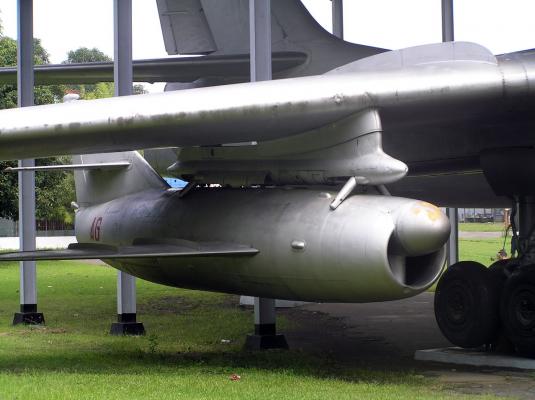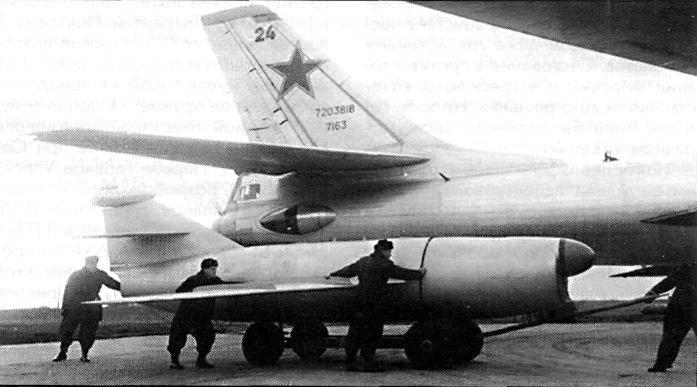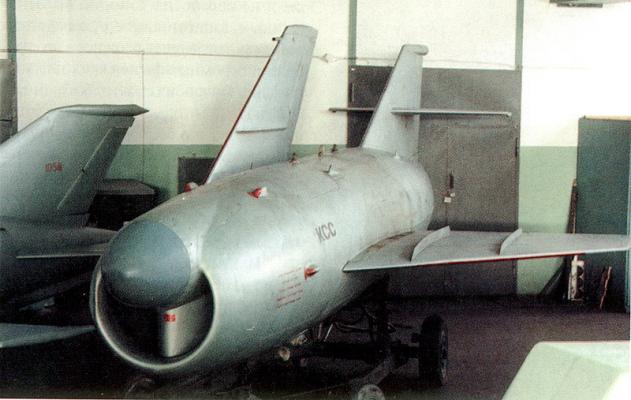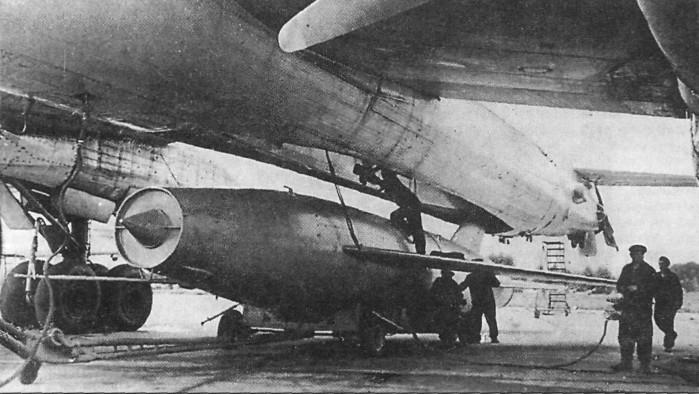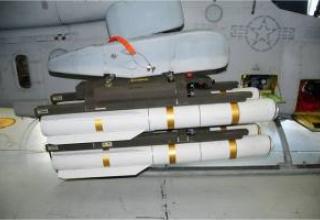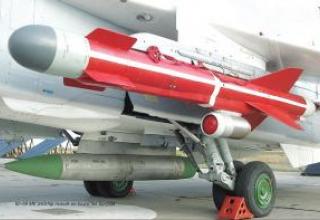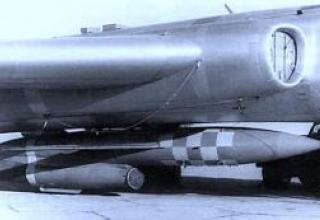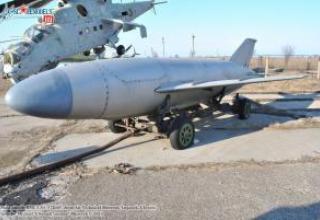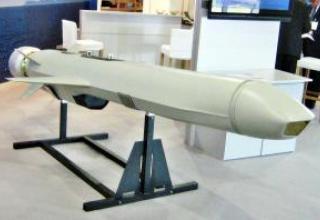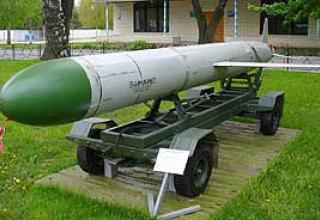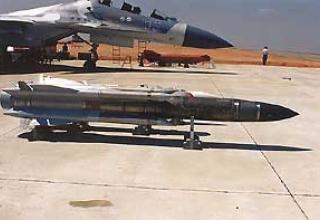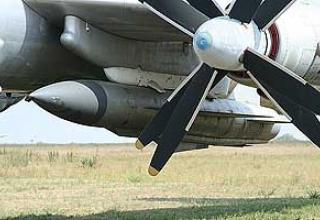On September 8, 1947 the USSR Council of Ministers Decree No. 3140-1028 was issued, according to which it was planned to create "Comet" anti-ship warplanes with a range of 100 km.
Special Bureau No. 1 (SB-1) was created specifically to work on guided missiles, subordinate to the Third Main Directorate under the USSR Council of Ministers. P.N. Kukseenko was appointed Director of SC-1, and S.L. Beria was appointed Chief Engineer. In August 1951, SB-1 was renamed KB-1 of the Ministry of Armaments. The development of the missile part of this complex, which received the designation "Comet-3" (K-III) was initially entrusted to the Design Bureau-155 A.I. Mikoyan. The Design Bureau-155, in parallel to the conventional aircraft, opened the subject of "B" for unmanned aerial vehicles under the leadership of M.I.Gurevich. However, the Design Bureau-155 was extremely busy with the main "fighter" theme and, in order to establish the work on the projectile aircraft, the construction of the pilot series and the development of production, in accordance with the Decree of the USSR CM of September 1, 1951, these tasks were transferred to the Moscow Region plant number 1 in the city of Ivankovo (now Dubna). By the order of MAP there was organized a branch No.2 of OKB-155, the head of which was Y.I.Bereznyak. Due to the significant novelty and importance of the Kometa task, unprecedented in scope research and testing were deployed (a solution that later on was quite significant for the success of the project, which became one of the most successful and reliable missile systems). By May 1951, the Tupolev Design Bureau-156 presented modified for the carrier Tu-4KS (aircraft number 224203), equipped with a radar "Comet-2" in a lowering fairing and a pair of beam holders BD-KS under the wing.
The tests of the aircraft itself were preceded by the flights of its manned analogue - the product "K", equipped with a test pilot's cockpit with a minimum of aerobatics and navigation devices in place of the standard BC and retractable in the fuselage bike landing gear. The analogue was designed to assess the flight performance of the missile and tuning of on-board equipment, including the combat modes with the pointing at a real target. Using the "K" aircraft allowed to significantly reduce costs and time for development of the complex.
The first flight of the analogue was performed by test pilot Amet-Khan Sultan from the airfield of the Air Force Research Institute in Chkalovskaya January 4, 1951, then the tests were transferred to the Crimean air force range. In May, began air launches of the analogue aboard the Tu-4. In total, the tests involved four aircraft "K", on which Amet-Khan, S. Anokhin, F. Burtsev, V. Pavlov and P. Kazmin performed 150 flights. With the transition to the development of launches on a real target was brought to the guidance and control system "Kometa" - the analogue after the reset went to the target, like a combat rocket, and only at the end of the pilot turned off self-homing, took control and returned to the airfield. All flights went well, although the pilots themselves considered them extremely difficult. In one such flight, Amet-Khan's analogue snapped off the suspension with a non-operational engine, which could be launched only at the water itself, in the other - Burtsev did not turn off autopilot and he could hardly overpower the steering machines, barely managed to turn away from the ship-target. In flights, he managed to identify another problem - icing of the rocket engine, especially in flights over the sea, when the crust of frost in the combustion chamber made its launch impossible. The way out was to introduce electric heating of the engine on the suspension.
The first launch of the rocket, made over the Sea of Azov at Arabatskaya shooter in May 1952, the crew of Captain VA Nikolsky, ended in failure - because of an error with the installation of the steering wheel missile "failed", passing the radar beam, and fell into the sea. In the course of further tests the system was brought to work and measures were taken to improve the stabilization of the missile, which suffered from instability on the heels. In one of the launches, the rocket after leaving the suspension hit the propellers of the carrier, damaging two motors at once and broke the control thrust of another. The manned analogue did not have such a tendency, but it was not possible to catch the cause. Since the aerodynamic missile differed from the analogue only by the absence of the cockpit flashlight, it was decided to restore it, imitating a dural hood. In this form, the "Comet" even went into series, and only later the defect caused by the specifics of the boom wing, was finally eliminated by adjusting the autopilot.
State testing of the system was held from July 1952 to January 1953 with positive overall results, with a number of achieved results exceeded the set. In their course, of the 12 missiles launched 8 hit the target - a former Guards cruiser "Red Caucasus", which was taken to the sea and plied after the removal of the crew at Feodosia. Avoiding excessive damage to the target, the missiles were used without BC, but the two-ton "Comet" at a speed close to the sound and without a charge broke through the ship's board, leaving holes of 5-10m2. Usually after the impact there was a big round hole from the rocket body and a couple of small holes from the wing cargoes, the wings themselves were cut as if by scissors. In one of the attacks, the missile hit the cruiser's turret with a direct hit, but the ship, patched up once again, remained afloat.
November 21, 1952 the crew of Nikolsky made the launch of "Comet" with the staff BC. Target, marching at 18-knot speed, was found at a distance of 120 km, with the removal of 80 km while standing on the crosshead of Yalta, the crew made the launch, a direct hit sent the ship-target to the bottom.
In 1953, the missile system "Comet" was adopted for service. By the Decree of February 3, 1953 its creators were awarded the Stalin Prize.
With the death of Stalin and the arrest of L. P. Beria, his son and other leaders of KB-1 were removed from business. The leading role in the work on "Kometa" gradually moved to the Moscow region branch of the OKB-155 led by AY Bereznyak, where the mass production of missiles. On June 2, 1953 the plant No.1 was redirected to MAP, having received No.256 (later - PA "Rainbow"). Smolensk plant ¹475 (according to the MAP Order of April 25, 1955) also joined the serial production. Kazan Aircraft Plant ¹22 re-equipped several dozens of Tu-4s into carriers.
For the development of "Comet" in maritime aviation in June 1953 in the Crimea at the airfield Guards was formed a special training unit number 27 under the command of Lieutenant Colonel Leonov. In December 1953, the crew made the first launch of the rocket "KS" on target - transport "Kursk". During the next two years of combat training the pilots of the unit made 18 launches, hitting targets in 14 of them. On the basis of the generalized experience, the unit headquarters prepared instruction on the combat activities of Tu-4KS aircraft.
Rocket weapons gave the maritime aviation qualitatively new possibilities - instructors characterized "Comet" as "long stick" of our fleet. The Directive of the GSH Navy of August 30, 1955 on the basis of the training unit in the aviation of the Black Sea Fleet was formed 124th TBASP long-range (since October 1957 - TMAP dd). In addition to 12 Tu-4KS and 8 Tu-4, it also had special simulators SF-5 based on MiG-17, equipped with guidance equipment "K-1". They were used instead of combat missiles for training of carrier crews. A similar missile equipment allowed to practice the attack in almost all modes, including homing, which allowed to save combat "Comet" and made it possible to analyze the operation of the complex according to the data of the aircraft simulator's onboard CAP. Later, there were more advanced KFOR-7 and KFOR-15 aircraft of the same purpose.
Further development of the Comet system was the Tu-16KS aircraft and missile complex. To do this, the Tu-16 was installed missile guidance equipment, worked out on the Tu-4KS. Improved the wing, placing on it beam holders BD-187 and the fuel system of the rocket. Since the place in the germ cockpits of the aircraft for the operator to point the missile was not found, then his cabin with a life support system is located in the cargo hold, fixed to the beams. The range of Tu-16KS with two missiles at maximum takeoff weight of 72000kg did not exceed 3135-3560km. Flight height of the carrier and its speed during the launch of the KS were originally within the range of 4000-4500m (later up to 7000m) and 370-420 km / h. The launch vehicle radar detected targets at a distance of 140-180 km, and the missile was launched at a range of 90-70 km. At the end of 1950s, after modification of the system, the launch range was brought to 130 km.
Tu-16KS tests began in 1954. The following year, the new complex was adopted for service. The first TU-16KS entered the Navy in late 1957, in the 124th Mine-Torpedoon Air Regiment (MTAP) of the Black Sea Fleet. The 124th MTAP included 12 TU-16KS, six TU-16ZSch tankers and a TU-16PS jammer. Then the 5th MTAP of the Black Sea Fleet was re-equipped with Tu-16KS missile carriers, and in 1958 the complexes started to arrive to the Northern and Pacific Fleets. By the end of the 1950s, 90 Tu-16KS complexes were in service with five MTAPs.
In 1957-58, a number of improvements were made to the missile system. Stock of fuel "KS" increased, increasing the range up to 130 km, achieved reliable launch to a height of 7000 m by raising the fuel pressure in front of the nozzles, and was able to perform the launch to a height of 10,000 m. An aeroid altimeter added a more accurate radio altimeter. For easy storage and transportation, the wing arms were made foldable. As a result of the operation, the units and waveguides of the guidance system were heated, eliminating the appearance of condensation, freezing and malfunctions for this reason. Optimizing the trajectory of the missile flight, modified the autopilot, providing an opportunity to launch from low altitudes - up to 2000 m.
The possibility of multiple launch of two missiles by one carrier was provided by their successive introduction into the beam of the radar and simultaneous guidance (the first such launch was carried out in early 1958, the crew of the commander of the 5th MTAP V. Dubina). Increasing the number of missiles in the attack, worked out the guidance of three missiles at once one airplane with launches from the combat order "column" squad Tu-16KS. Launches were carried out at intervals of 15-20 seconds. coming on command of the leading missile took his operator to escort him.
High-altitude launches proved to be tactically unprofitable - the plane was coming out of the attack too close to the target, being at risk of air defense defeat. By calculation, when launched from a distance of 90 km and an altitude of 10,000 m aircraft at the time of hitting the missile was 24 km from the target, while at launch from the same range, but from a height of 2000 m Tu-16 out of attack in 43 km from the target. Low-altitude launch increased the tactical surprise, providing a covert exit into the attack, and the probability of defeat at launch from 2000 m gave normal results - 2/3 of the missiles hit the target (ie, launching a pair of missiles guaranteed the solution to the problem).
Serious counteraction could have been provided by the opponent's REB, which prompted new modifications to the system. Since 1961, the missiles were equipped with interference-resistant blocks of equipment, which not only increased their protection from the means of airborne radar, but also reduced the sensitivity to mutual interference radars of their own aircraft, disrupted the synchronization of K-1M. For the test conducted 8 launches of KC-1 from aircraft, whose stations worked on one frequency, and 6 missiles accurately hit the target. Positive results were also obtained in the group attack of missile carriers from six different directions, which fired missiles in less than a minute. All this enabled the missiles to master the group application by massaging their number and launching a starburst from different angles.
Five missiles were assembled with thermal GSN "Sputnik-2", but were not adopted for service - the ship, as a heat emitting object, was a low-profile target, and this direction has not received development.
In the Navy, the successful and well-developed missile system "Comet" remained in service for almost a decade and a half - until the end of 60s, when it was replaced by more modern systems. Being in service Tu-16KS were re-equipped for new complexes: so, since 1962, 65 machines were modified for the missile system K-11-16.
Tu-16KS was supplied to Indonesia, where 25 aircraft arrived in the summer of 1961, as well as Egypt, where they were equipped with two squadrons. There is no reliable information about any cases of combat use of the Comet there, although the appearance of Indonesian missile carriers was observed near the British military base in Singapore.
Tu-16KS did not manage to participate in real hostilities, but some of them were delivered to Indonesia and the OAR.
Composition:
The airplane shell "KS" was an all-metal monoplane of predominantly riveted construction (see layout diagram, projections 1, 2). The wing with a sweep of 55 °, had a two-span construction with the usual ailerons control on the roll. Tail fins carried the steering wheel height and turn. The fuselage on the design and power scheme and layout was almost the same as the MiG-15, differing in the presence of a large compartment of control equipment and BC instead of the cockpit. The main materials were dural D16T and steel 30 CGSD in the responsible joints, radio transparent fairings were molded from foam.
BC 4G52 of blast action weighing 1015 kg carried half a ton of TNT and was equipped with a contact fuse. The BC was installed in place through a large upper hatch (the possibility of removal was dictated by the anticipated nuclear charge, removable for routine work, but such equipment "KS" was not carried out).
The compartment behind the BC was occupied by a fuel tank containing 330 liters of kerosene. The antenna units of "K-1" system were located in the tail at the top of the keel (backward-facing beam-facing antenna) and in the nose above the air intake (parabolic antenna of semi-active CNS with target coordinator).
The ducts descending from the frontal air intake came together in front of the RD-500K engine, a short resource version of TRD with unregulated thrust. At first, the missiles were equipped with conventional aircraft engines that came after the exhaustion of the resource and bulkhead. As the production of missiles increased, the industry mastered a special version of RD-500K, characterized by the use of cheaper units and materials sufficient for a short engine run. Simplified and lightweight RD-500K was single-mode. A part of regulation system automatics was removed from it, the start instead of electric starter was provided by pyrotechnic unit. Compared to the original engine, the weight was reduced by 100 kg - from 581 to 481 kg. In addition to the production of RD-500 plants ¹500 in Moscow and ¹16 in Kazan, specially for cruise missiles deployed since 1958 production of RD-500K at plant ¹ 478 in Zaporozhye, which gave 595 engines.
The method of application of the missile system looked as follows (see diagram): using the radar, the carrier aircraft detected the target, and then the station was switched to automatic tracking. With reaching the launch boundary from a distance of 70-90 km at a speed of no more than 360 km / h and a height of 3000-4000 m (under the conditions of starting the rocket engine) was launched. When leaving the launch vehicle, the rocket sat down, losing altitude so as not to hit the launch vehicle, and with acceleration went forward, hitting the radio beam that directed it to the target. The flight altitude was controlled by a barometric altimeter, preventing the missile from dropping excessively and getting caught by obstacles.
At a distance of 20-30 km from the target, when the radar signal reflected from the target became strong enough to sustain the CNS, the pointing was switched to it. After launch, the aircraft proceeded at a reduced speed of up to 320 km/h, lagging behind the rocket and continuing to illuminate the target until it is hit. By the time the missile met its target, the carrier was 40-50 km away and was able to exit the attack, remaining well beyond the reach of anti-aircraft fire.
Characteristics:
| Range of fire, km | 80-90 (130-150) |
| The height of the flight is cruising, m | 400 |
| Flight Speed, km/h. | 1060-1200 |
| Dimensions, m length altitude maximum housing diameter wingspan wing angle |
8,29-8,44 2,457 1,2 4,722 (4,8-4,9) 57,5 |
| Start weight, kg | 2,735-2,737 (2,750) |
| Engine | TRD RD-500K |
| Engine traction, kg | 1490-1500 |
| Engine weight, kg | 481 |
| Fuel weight (kerosene T-1), kg | 165 |
| Weight of oil, kg | 110 |
| Holder type | beams BD-KS (Tu-4KS) and BD-187 (Tu-16KS) |
| BC | shrapnel-flag, K-450 (further 4G52) |
| Weight BC, kg | 933-980 (1015) |
| The weight of the explosive, kg | 500 |
| Control System | radio team with PARLGSN K-IIM |
| Range of CNS, km | 10-20 |
| Autopilot | APK-5B (AP-5) |
| Carrier speed, km/h. | 370-420 |
| Launch altitude, km | 3000-5000 |
| Airplane carrier | Tu-4KS, Tu-16KS |
Testing:
Operation of the K-20 in combat units of the Air Force began in August 1959, when the first missile carriers entered the 1006th TBAP in Uzin near Kiev. By the end of the year, the Tu-95K received the 1226th TBAP in Semipalatinsk, and then the 182nd TBAP in Mozdok. February 14, 1963 the first Tu-95KM arrived in Uzin.
The main objectives of the K-20 system were considered the most important military and industrial facilities in the United States. These included air bases and nuclear storage of strategic aviation in the North near the Canadian border, in Texas, California and Louisiana in the south of the country, missile bases and control centers in the central states, a cascade of energy facilities in the Great Lakes, nuclear centers and Texas oil fields (at that time, most of the oil and gas for the American economy gave its own fields), as well as naval bases and ports on the U.S. coast and islands in the Pacific and Atlantic Oceans. The courses for most of the targets were along the "Chkalov Route" - the shortest way across the pole, or to the west coast of the American continent.
Many objects were at the limit of reach, and crews regularly worked on relocations and actions from advanced airfields in the North, Far East and Arctic, where ice platforms were used (such exercises in YES were held at least twice a year). The flights were refueled, air defense breakthroughs at low altitudes, group and single strikes were mastered. The crews knew the future goals in detail, studied the environment, relief, radar and other landmarks, approaches and launch areas.
Constant combat duty in the YES regiments complicated the laborious preparation of X-20M. It was necessary to fill the rocket with fuel, special liquids, air and nitrogen, to check the systems and test the engine. If the launch was supposed to be tactical, without dropping the rocket, then often did not install a sub-basement keel, which was attached to more than a hundred screws.
The very suspension of the X-20 under the aircraft required a great deal of effort and skill. The trolley from a three-meter height was squeezed under the fuselage, forcing to turn the stirring blades of screws and jewelry "guessing" the keel of the rocket into the opening of the cargo compartment. The trolley "squatted", allowing to win the extra centimeters, but in this position after half an hour landed on the ground irrevocably. More than once during the sunset, the antennas at the top of the keel were demolished, which were protected by a special frame (with it, when "touching" the antenna remained intact, but sometimes the keel itself was crushed). To roll the X-20 required the efforts of at least 15-20 people.
The assigned resource of the X-20 was determined by the storage time, the flight under the carrier and the number of tactical launches. Repair and refinement of missiles were performed by the ARP. In this case, delivery of missiles in repair is often made by the carriers themselves Tu-95K.
Work with nuclear equipment of missiles had a proper place in combat training, but in the regiments was always carried out using special simulators and training and combat products equipped with all the necessary systems, but without a nuclear charge, allowing to practice all operations on the preparation and use of special BC.
When carrying out offsets launches X-20M were equipped with a training BC with a blast charge, which gave a noticeable explosion and "mark" at the point of impact, which allowed to judge the accuracy of the target. During the combat training from January to October 1962 the Tu-95K crews made 19 launches of X-20M, of which 15 were considered successful. By the time the K-20 was adopted into service was a quite effective system. According to the then assessment, the probability of intercepting a cruise missile by air defense fighters did not exceed 0.02 ... 0.05%, and this was confirmed by the students with the launch of the real X-20, passed through the zone of the object of air defense over one of the ranges. Even after its detection, the radar failed to point anti-aircraft missiles and interceptors to a supersonic high-altitude target - in the front hemisphere, those were ineffective, and breathtaking to catch a high-speed missile was not possible.
However, after a few years, the capabilities of the K-20 seemed insufficient. First of all, this was due to the growing level of air defense, saturated with anti-aircraft systems of zonal defense with long range and altitude, as well as supersonic fighters, capable of intercepting aircraft and shells, and the missile carriers themselves on remote borders to 1000-1200 km. The tasks of defeating strategic targets shifted to intercontinental ballistic missiles, which at that time looked like an absolute weapon. In December 1959, the Strategic Missile Forces were formed, where, in accordance with the Order of the USSR Ministry of Defense of December 31, 1959 and the directive of the General Staff of the Air Force of the former 18th, 48th and 50th IA YES were transferred to the missile parts, units and two army departments. As the units of the Strategic Missile Forces were put on combat duty, many tasks of the YES began to be assigned to them.
The regiments with the K-20 system that were in service of the Air Force were increasingly focused on solving tasks at sea - the defeat of naval bases and hunting for AUG. Ensuring their performance, the crews of missile carriers were also involved in conducting intelligence at sea, acting in conjunction with the scouts Tu-95MR. During the operation of the complex it was possible to reduce training time and labor intensiveness. Launches on maritime targets were carried out in the Caspian Sea, where the range with the appropriate telemetry and traceological equipment provided control over the flight of missiles (if necessary, in the case of failure and departure from the trajectory - their explosion). Anything happened - once in 1983, after ten years of operation of the complex, the crew mistake in tactical launch led to an involuntary discharge of the rocket. That went off the suspension with the engine running and, catching up with the plane, hit it in the fuselage. The crew successfully got home on the damaged plane, and the X-20M crashed into the sea, where it was then long and unsuccessfully sought by the Caspian Flotilla sailors.
The reliability of the complex grew as it served, reaching an acceptable level. With the last firing, conducted in 1006 TBAP in 1987, from the launched dozen missiles all worked off routinely, hitting conventional targets at the range. However, it was already a farewell chord - the combat efficiency of the K-20 complex, created in accordance with the requirements of 1954, looked disappointing, and the chances of performing a real combat mission in the conditions of modern air defense, equipped with early detection systems, air points DRLO, the latest SAMs and interceptors (and deck "Tomkata" with missiles "Phoenix" appeared just in response to the threat of Soviet missiles) - completely untenable.
However, with the write-off of the Tu-95K was not in a hurry - for a long time, long-range vehicles with air-based missiles were not fully replaced. The main emphasis was on the development of other components of the nuclear triad, and in the creation of strategic aircraft and missile weapons for them qualitative changes occurred only in the early 80's, when the long-range cruise missiles X-55. Part of the Tu-95KM, having been re-equipped for a more modern complex K-22, remained in service. Continued to be in the Air Force and the former Tu-95K - by the fall of 1990, a dozen and a half of these machines were in Ukrainka, another one remained in Uzin. These aircraft went into disrepair only after the signing of the Treaty on Strategic Offensive Arms START-1 in 1991. Thus, the service life of the K-20 complex in the Air Force was more than 30 years.
Sources:
- С.Мороз, Попсуевич. Управляемые ракеты дальней и морской авиации СССР
- А.В.Карпенко, С.М.Ганин, В.В.Колногоров. Авиационные ракеты большой дальности. Отечественные авиационные ракеты
- Марковский В., Перов К. "Авиационные крылатые ракеты" // Авиация и космонавтика. N 10 / 2005 г
- Ракетный комплекс КС-1
